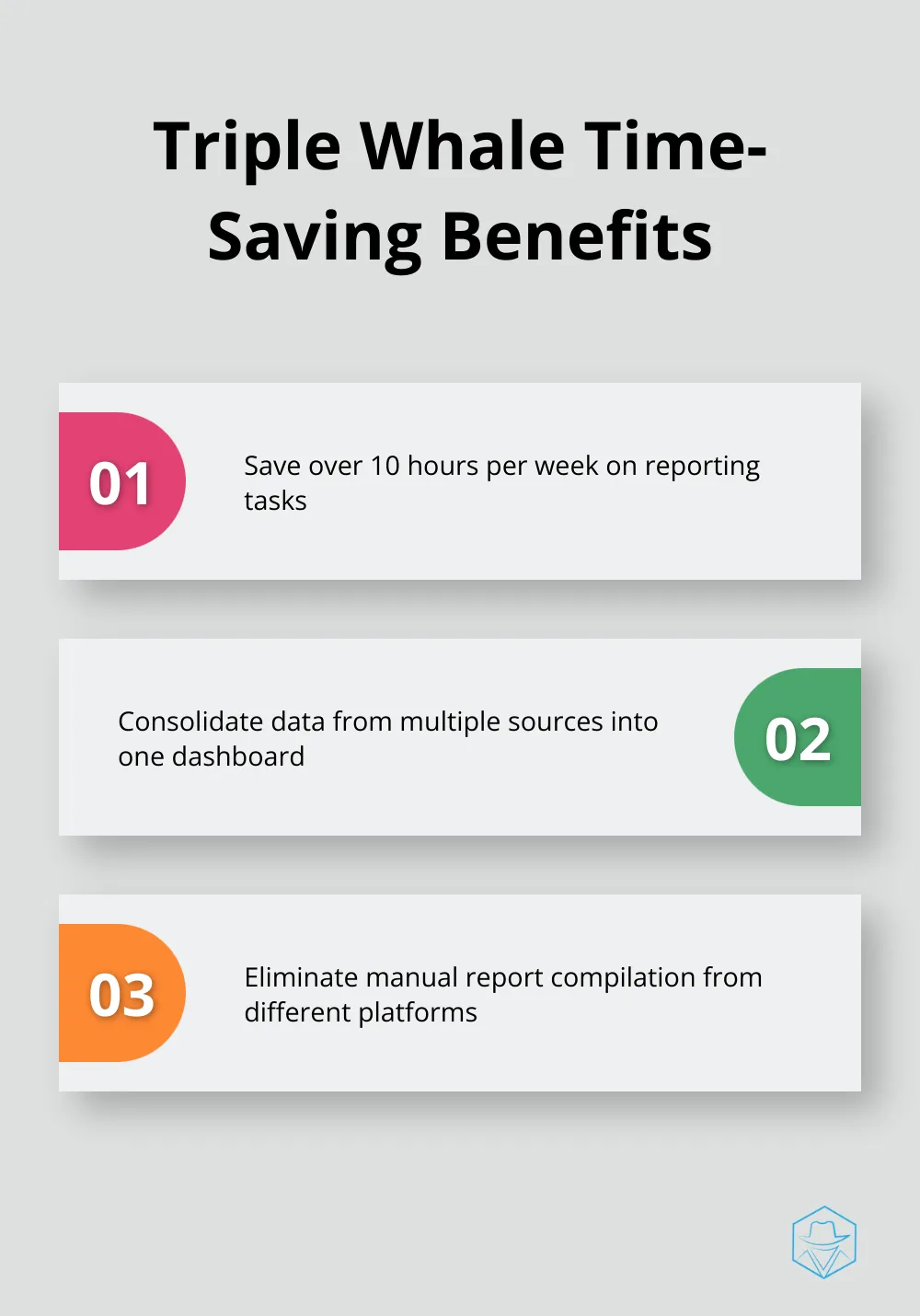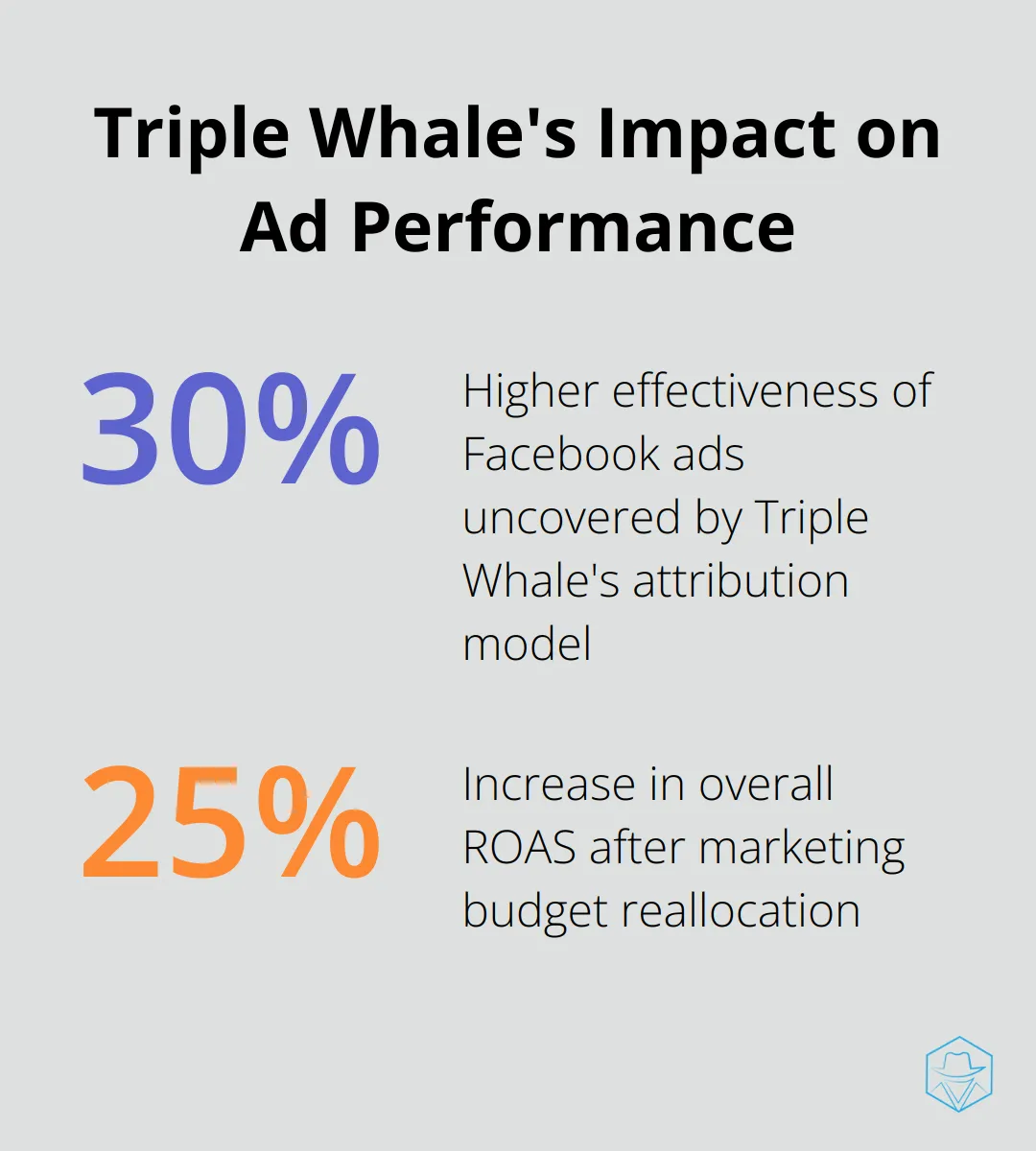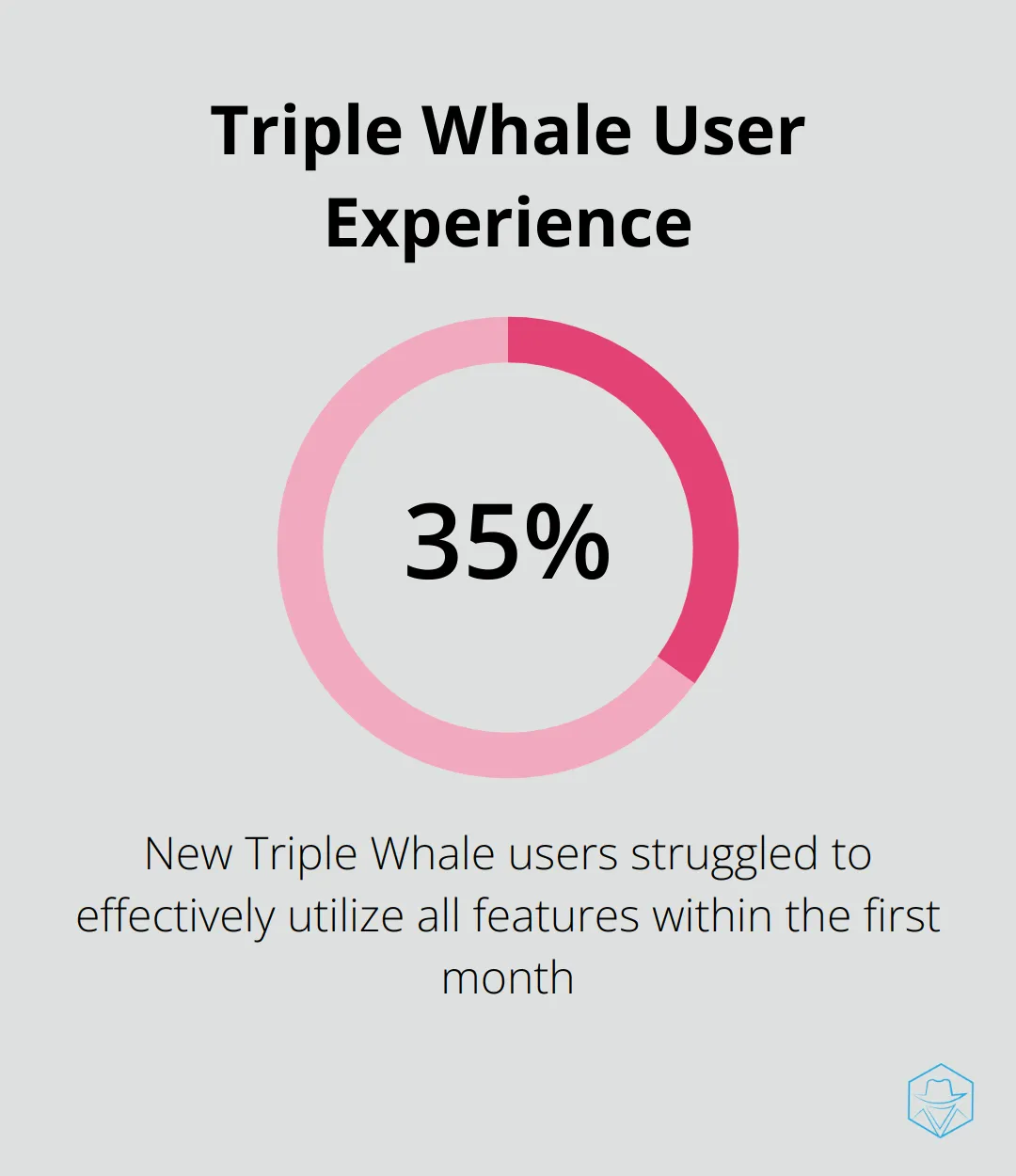Is Triple Whale Worth It? An Honest Review

At Drop Cowboy, we’re always on the lookout for tools that can boost e-commerce success. Triple Whale has been making waves in the industry, promising to revolutionize data analytics and performance tracking for online businesses.
In this Triple Whale review, we’ll examine whether this platform lives up to the hype. We’ll explore its features, benefits, and potential drawbacks to help you decide if it’s the right investment for your business.
What Is Triple Whale
Triple Whale is a data analytics platform tailored for e-commerce businesses. It centralizes metrics from multiple sources (such as Shopify, Facebook, and Klaviyo) to provide a comprehensive view of online store performance.
Comprehensive Data Integration
Triple Whale excels at data consolidation. It pulls information from various channels and presents it in a unified dashboard. This eliminates the need to juggle multiple tabs or export data from different platforms to get a clear picture of business performance.
Real-Time Performance Tracking
A standout feature of Triple Whale is its Live Orders functionality. This feature updates sales in real-time, displaying orders made after customers interact with ads. It helps businesses understand the immediate impact of their marketing efforts.
Advanced Attribution Modeling
Triple Whale uses a first-party pixel to offer accurate performance reporting. This proves valuable in light of Apple’s App Tracking Transparency framework, which has affected tracking accuracy for platforms like Facebook. The platform’s attribution model helps users understand which marketing channels drive their sales.
Target Audience
Triple Whale primarily caters to Shopify merchants, with over 2,500 businesses using the platform. It benefits direct-to-consumer (D2C) brands and agencies looking for in-depth analytics and attribution data. The platform scales to serve businesses from startups to established brands generating millions in revenue.
Limitations
While Triple Whale offers robust features, it’s not a one-size-fits-all solution. Businesses with revenues under $10 million or those with short purchase consideration windows might find some of the advanced attribution features less beneficial. Additionally, Triple Whale is designed exclusively for Shopify, so users of other e-commerce platforms will need to look elsewhere.
In the competitive landscape of e-commerce analytics, Triple Whale stands out for its focus on Shopify integration and advanced attribution modeling. However, it’s important to consider specific business needs and compare different options before making a decision. While Triple Whale offers powerful analytics, other platforms (like Drop Cowboy) provide unique communication tools that can complement e-commerce strategies, especially in areas of customer engagement and personalized marketing. As we explore the pros and cons of Triple Whale in the following sections, we’ll provide a clearer picture of how it stacks up against other solutions in the market.
Why Triple Whale Stands Out
Unified Data Dashboard
Triple Whale’s ability to consolidate data from multiple sources sets it apart in the e-commerce analytics landscape. This feature eliminates the need for manual report compilation from different platforms. A mid-sized Shopify store reported a time savings of over 10 hours per week on reporting tasks after implementing Triple Whale.
The platform integrates data from Shopify, Facebook, Google Analytics, and other major e-commerce tools. This centralized approach enables businesses to identify trends and make decisions based on a comprehensive view of their performance (rather than piecing together information from disparate sources).

Advanced Attribution Modeling
Triple Whale addresses a significant challenge in the e-commerce industry with its first-party pixel technology: accurate attribution. This solution provides a more reliable method to attribute sales to specific marketing efforts, especially in light of iOS privacy changes that have impacted traditional tracking methods.
A D2C brand’s case study revealed that Triple Whale’s attribution model uncovered 30% higher effectiveness of their Facebook ads than previously thought. This discovery led to a marketing budget reallocation and a subsequent 25% increase in overall ROAS.
Real-Time Performance Insights
The Live Orders feature revolutionizes how businesses understand the immediate impact of their marketing efforts. Marketers can observe orders coming in right after an ad interaction, which provides instant feedback on campaign effectiveness.
This real-time data proves particularly valuable during high-stakes events such as product launches or flash sales. A beauty brand utilized Triple Whale during a new product release and adjusted their ad spend in real-time based on performance. The result? A 40% higher conversion rate compared to previous launches.

Customizable Dashboards
Triple Whale offers users the flexibility to create tailored dashboards that highlight the metrics most relevant to their business. This customization allows for quick access to critical data points and facilitates more efficient decision-making processes.
Benchmarking Tools
The platform includes benchmarking features that enable brands to compare their performance metrics against industry peers across 21 different categories. This comparative analysis helps businesses understand their standing in the market and identify areas for improvement.
While Triple Whale boasts these impressive features, it’s worth noting that other platforms offer unique tools that can complement these analytics capabilities. For instance, Drop Cowboy provides innovative communication solutions (such as Mimic AI™ and ringless voicemail) that can enhance customer engagement strategies based on insights gained from data analysis platforms like Triple Whale.
As we explore Triple Whale’s strengths, it’s clear that the platform offers significant value for e-commerce businesses. However, to provide a balanced perspective, we must also consider potential drawbacks. Let’s examine some limitations and challenges users might face when using Triple Whale.
The Hidden Costs of Triple Whale
Triple Whale has garnered attention for its robust analytics capabilities, but it’s not without its drawbacks. Let’s explore some of the challenges users might face with this platform.
Steep Learning Curve
Triple Whale boasts a user-friendly interface, but users often need several weeks to master its full potential. This learning period can delay the realization of benefits, especially for smaller teams with limited resources.
A survey conducted by E-commerce Insider found that 35% of new Triple Whale users struggled to effectively utilize all features within the first month. This challenge can be particularly acute for businesses without dedicated data analysts or marketing specialists.
Platform Limitations
Triple Whale’s focus on Shopify integration is both a strength and a weakness. Businesses using other e-commerce platforms (like WooCommerce or Magento) cannot use Triple Whale. This exclusivity limits its potential user base and may force some businesses to seek alternative solutions.
Moreover, while Triple Whale offers integrations with major marketing platforms, it may not cover all the tools in a company’s tech stack. A mid-sized retailer reported difficulties integrating Triple Whale with their custom CRM system, leading to data silos and incomplete analytics.
Pricing Concerns
Triple Whale’s pricing structure can be a significant hurdle, especially for smaller businesses or startups. The platform’s cost is based on revenue tiers, which means as your business grows, so does your Triple Whale bill. This can lead to unexpected cost increases that may strain budgets.
For example, a growing D2C brand saw their Triple Whale costs jump from $129 to $299 per month after crossing the $1 million revenue threshold. While the additional features at higher tiers can be valuable, the sudden price hike can be challenging to justify for businesses operating on tight margins.

Data Accuracy Challenges
While Triple Whale’s first-party pixel aims to improve attribution accuracy, some users have reported discrepancies between Triple Whale’s data and other analytics platforms. These inconsistencies can lead to confusion and potentially misguided decision-making.
A case study by Marketing Analytics Today found that 15% of surveyed Triple Whale users reported significant discrepancies (over 20% difference) between Triple Whale’s attribution data and their Google Analytics results. Such variances can complicate reporting and strategy development.
These challenges don’t necessarily negate Triple Whale’s benefits. However, businesses must weigh these factors against their specific needs and resources. For those seeking alternative solutions, platforms like Drop Cowboy offer unique communication tools that can complement or even replace certain analytics functions (especially in areas of customer engagement and personalized marketing).
Final Thoughts
Triple Whale offers significant value for many e-commerce businesses, particularly those using Shopify. The platform’s unified data dashboard, advanced attribution modeling, and real-time performance insights provide powerful tools for data-driven decision-making. However, businesses must consider challenges such as the steep learning curve, Shopify-exclusive focus, and potential data accuracy issues when evaluating this tool.
Large Shopify-based e-commerce businesses with complex marketing strategies may find Triple Whale a worthwhile investment. Mid-sized Shopify stores looking to scale their operations might also benefit from the platform’s comprehensive analytics and attribution capabilities. Smaller businesses or startups should carefully evaluate whether Triple Whale’s advanced features align with their current needs and budget.
While Triple Whale excels in analytics, it may not address all aspects of e-commerce success. Effective customer communication remains crucial for converting insights into sales. Drop Cowboy complements analytics tools by providing innovative communication solutions such as ringless voicemail and SMS marketing with AI-powered voice cloning. The value of Triple Whale depends on your specific business needs, resources, and growth stage.
blog-dropcowboy-com
Related posts

April 4, 2025
Creating Compelling Content for Marketing Automation
Boost your strategy by creating compelling content for marketing automation. Discover practical tips and tools to enhance engagement and conversion.

March 22, 2025
Top iPaaS Tools for Seamless Data Integration
Explore top iPaaS tools for seamless data integration. Discover efficient solutions for enhancing connectivity and streamlining your business processes.

March 21, 2025
How to Boost E-commerce Sales with SMS Marketing
Boost e-commerce sales effortlessly with SMS ecommerce strategies. Discover practical tips and proven methods to engage customers and increase revenue.

April 14, 2025
What is Triple Whale and How Can It Boost Your Business?
Learn what Triple Whale is and how it boosts business growth with data analytics and insights, driving sales and increasing efficiency.

March 1, 2025
Text Marketing Examples That Drive Results
Explore text marketing examples that boost engagement and deliver results with proven strategies for increasing conversions effectively.

April 9, 2025
Twilio Ringless Voicemail: What Is It and How Does It Work?
Explore Twilio ringless voicemail and learn its benefits and how it works for seamless communication without disturbing your recipients.